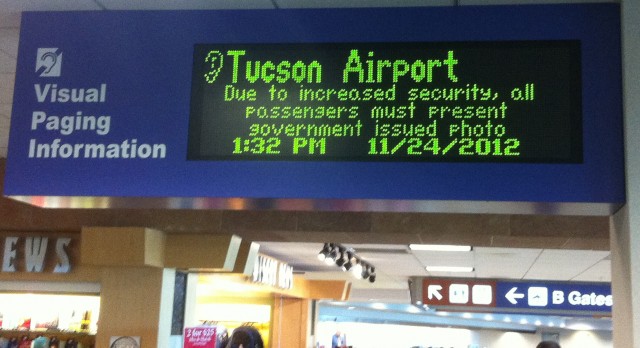
This sign is actually lying. This photos was taken via an iPhone just minutes before getting through security without valid photo ID.
This guest post was written by Jenny Brown, mother to David Parker Brown, the Founder of AirlineReporter.com. Notes in italics in the story are from David:
Unlike my son, a perfect flight is an uneventful flight. However, when I flew to Tucson in November, several events occurred that made my flight more of an adventure than I wanted.
It began when I boarded an Alaska Airlines flight from Seattle-Tacoma International Airport (SEA) to Tucson (TUS) on November 14, the only non-stop between the two cities. I usually fly first class (I was flying economy next to the lavatories -David) mainly because I am a reluctant flier and it allows me to relax more and get on and off the plane quickly.
So, the first class passengers were settling in when I heard the flight attendant say to the pilot, ’œSo, what’s wrong with the plane?’ Not something I wanted to hear! The voice on the intercom eventually told us that the co-pilot’s instruments were not working in the flight deck and it would take about two hours to fix. We deplaned to wait at the gate. Periodically, we were given updates and thanked for our patience. How the voice over the intercom knew we were being patient, I don’t know (Wait, isn’t this story about your ID mom? -David).
After a bit over two hours, we were told that another plane was being brought in and we eventually made it to Tucson.
While in Tucson, enjoying my family for Thanksgiving, I for some reason was looking in my purse for my driver’s license. I couldn’t find it. Yikes… I am undocumented in Arizona! (Let’s not get too political here -David). How am I going to get back to Seattle? What do I do? Call my son of course!
Luckily he helped out and emailed Alaska Airlines as I checked out their website as well as TSA’s. I also called Alaska Airlines and Cindy reassured me that I would make it home. Much to my surprise, I discovered that a photo ID is not necessary to fly, even though so many make you feel that it is required.
A list of other identification was given, including voter registration and social security card. I had both in my wallet as well as an expired passport with a 16 year-old photo. Thank goodness I don’t clean out my purse (I have since talked to my mom about having so many ID’s and identity theft, but that is another story – David).
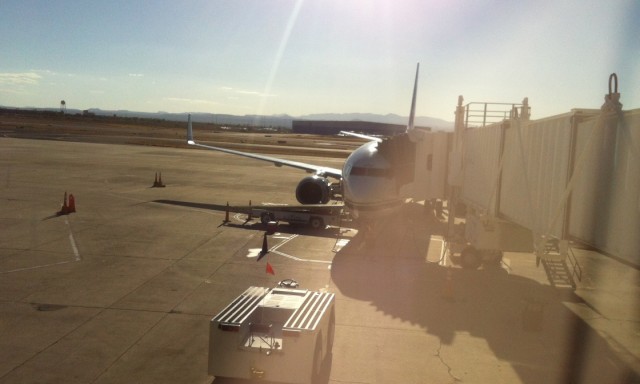
Top tier (that is sarcasm) iPhone photo of our Alaska 737 at TUS. Image by David (not that I really want to take credit).
I was still nervous about getting through TSA on the way home. Fortunately, David was returning on the same flight (he came down later), so he was there as son and journalist.
At the ticket counter, the Alaska agent was again very helpful (Well, technically, it was a Delta employee who was being contracted out to operate the counter for Alaska, but that is okay, she was very nice -David).
Then there was no line at security (Yea, that almost never happens -David). The TSA agent was very understanding and accepted the ID I had available. David was taking notes and photos; he seemed disappointed that I wasn’t whisked away to a room for ’œinterrogation’. Would make for a better story (No way, I am happy nothing bad went down. Although a nice frisking and detaining of my mom would have provided interesting content. -David).
Final Chapter: So after getting home safe and sound, I went to pick up my held mail at the post office the next day. The postal worker asked for a photo ID. I showed my voter’s registration and Social Security card to no avail. Finally, he reluctantly accepted my expired passport. I told him the postal service is tougher than the TSA. He said this is the US mail!
In my held mail was my driver’s license-sent by Alaska Airlines.
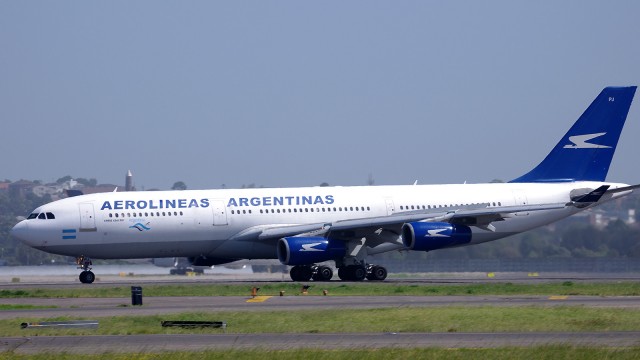
An Aerolineas Argentinas Airbus A340. Image by Malcolm Muir.
Thursday 17th January saw two events in aviation that normally would have made headlines, but with all the Boeing 787 issues and American revealing their new livery, these two interesting events have been overshadowed.
The first event to happen in Miami at approximately 545pm EST when an Airbus A340 flown by Aerolineas Argentinas touched down after flying from Buenos Aires. As it was taxiing to the gate it collided with an Air France 777-300 preparing to depart for Paris.
BONUS: The NYDailyNews has a photo of the two aircraft
The collision caused damage to the tail and wingtips of the aircraft. Emergency crews showed up, but thankfully no injuries occurred. Those passengers on the arriving aircraft were allowed to disembark, however the Air France passengers were unable to depart for Paris.
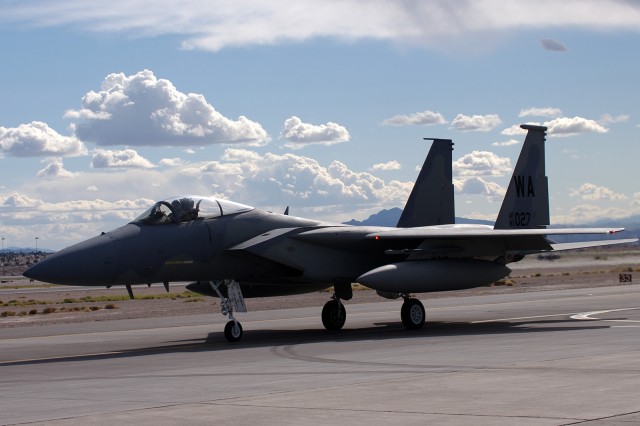
Normally it is not the best to see one of these outside your window. Image by Malcolm Muir.
On the opposite side of the country, around 6:00pm PST, two F15Cs of the Oregon Air National Guard were scrambled from their base at Portland International Airport. The two jets from the 142 Fighter Wing were sent to escort Alaska Airlines flight 819, a Boeing 737, from Kona Hawaii to Seattle.
A hijacking threat had been made against the flight and the passenger involved in the threat was monitored by crew. Alaska Airlines told AirlineRepoter.com that, “This passenger did not display any unusual behavior and was asleep much of the flight.”
Officials made the decision to escort the aircraft into Seattle and the flight touched down in Seattle at 707pm PST where they were greeted by the TSA and the Port of Seattle Police. According to KING5 News, the FBI interviewed the passenger for approximately two hours and FBI Spokesperson Ayn Dietrich said that they do not anticipate an arrest. Turns out that the passenger was cooperative and the investigation will now look into who called in the possible hoax or practical joke.
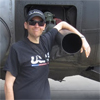 |
This story written by…Malcolm Muir, Lead Correspondent. Mal is an Australian Avgeek now living and working in Seattle. With a passion for aircraft photography, traveling and the fun that combining the two can bring. Insights into the aviation world with a bit of a perspective thanks to working in the travel industry.@BigMalX | BigMal’s World | Photos |
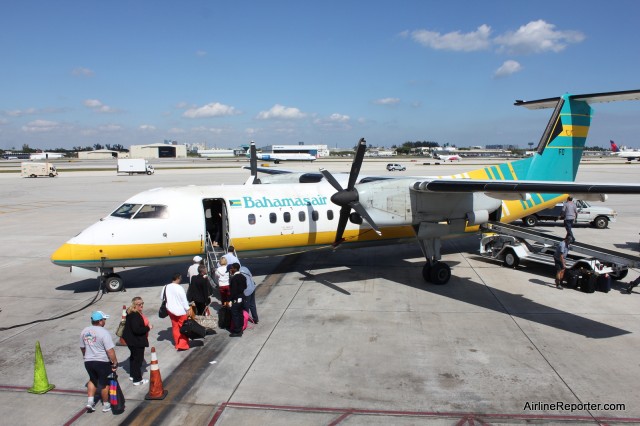
Bahamasair Dash 8 300 at Fort Lauderdale.
Who wouldn’t be excited about taking a press trip to the Bahamas? Of course, for an AvGeek, getting there is half the fun. I wasn’t super excited about my red-eye from Seattle-Tacoma International Airport (SEA) to Fort Lauderdale-Hollywood International Airport (FLL). I was excited about flying on Bahamasair from FLL to Lynden Pindling International Airport (NAS). This was the first time flying on Bahamasair and I hadn’t been on a Boeing 737-500 in quite sometime (note: The Bahamas Ministry of Tourism, which also oversees the airline, covered the cost of my trip).
Before leaving Seattle, I did some research on the airline and found that many passengers have publicly complained about their flights being consistently delayed. Many of the reviews were older and the airline had recently upgraded from the very aged Boeing 737-200 to the newer (but still old) 737-500 and I was hoping most of these issues would have been resolved (foreshadowing? yup).
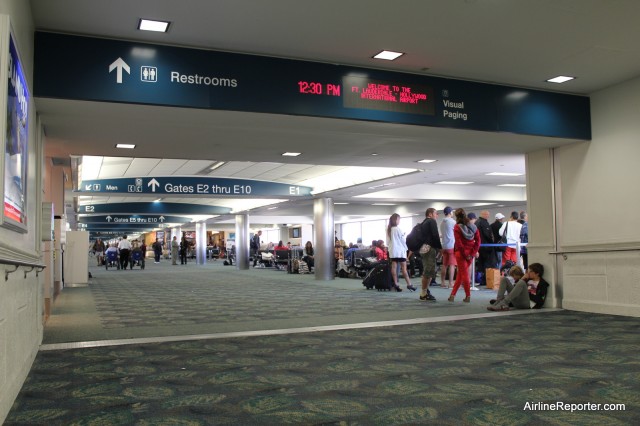
Trying to find an outlet and being able to hear announcements was not easy. I ended up sitting on the floor in a busy hallway, but whatever.
By the time my flight landed at FLL, I was pretty tired from getting three hours of sleep. It was about 7am and I was supposed to have a two hour layover before heading to the Bahamas and it was time for me to find my way to my new gate.
I had to transfer terminals at FLL, which requires a short shuttle ride that was supposed to run every 15 minutes, but I ended up waiting almost 30. This was not a huge deal since I had the time, but if my connection was close, that would have surely caused additional stress.
Once getting off the shuttle I had to wait in a short line to check in at the ticket counter since the airline does not currently have a web check-in option. I received my boarding pass and then had the “privilege” of going through security for the second time that morning.
After finding my gate, I moved down towards the end of the terminal to try to get a good photo of the 737-500 taxiing. The flight status board showed the arriving flight was on-time, but time passed and no plane showed. The status board continued to show “on time,” even after it reached 8:55am, when my flight was supposed to be departing. Odd.
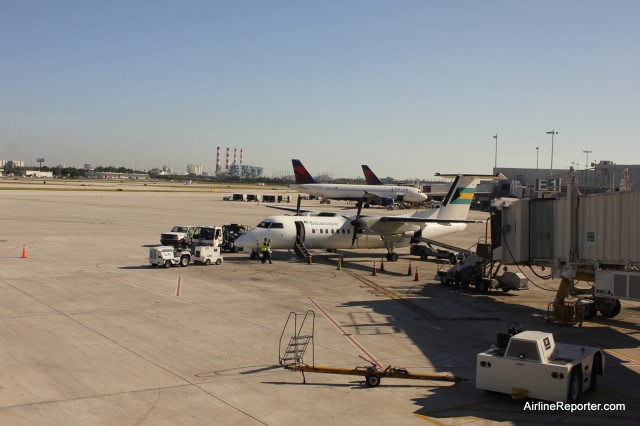
How many Dash 8’s does it take to replace a Boeing 737? Two. The first one wasn’t as colorful as the second (this is the 1st). Notice the air stairs going up to the jetway.
I can handle flights being late. However, I have less patience for lack of communication. The fact that there was not even a gate agent present was pretty bad. Needless to say, there were quite a few passengers pacing around who were getting quite frustrated.
Time kept rolling along before the board finally showed our new departure time was at 11:30am. Our gate had also changed from E3 to E1 where amazingly there was a gate agent there. I had no connecting flights to make, so I wasn’t too worried about the delays. Unfortunately this was the time that I really started to regret my decision to put my laptop in my checked bag — I could have been blogging.
After a while, it was announced that our Boeing 737-500 had broken down and they were trying to get two Bombardier Dash 8 300s to FLL. Some passengers showed their anger that they now had to fly on a small prop plane instead of a jet. As an AvGeek, I was pretty excited for the wings being up high, flying lower, no middle seat, and tarmac boarding.
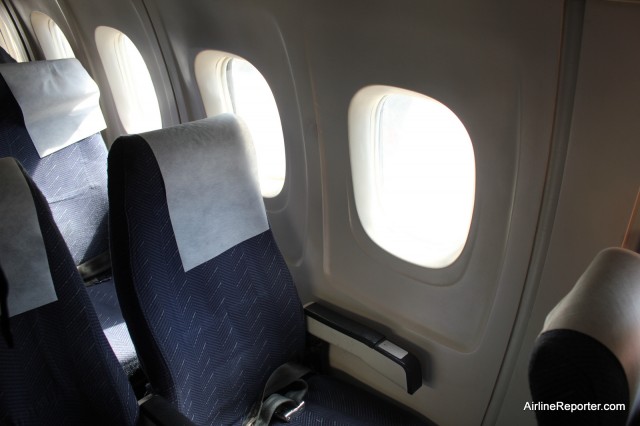
Not the most spacious, but for a 45min flight, it does the job.
At about 11:30am the first Dash 8 showed up. It was announced that people with connections, people with kids and those who needed additional assistance could board plane 1 and the rest would take plane 2.
As our flights (plural now) became more delayed, some passengers got very angry and unfortunately took it out on the gate agents. It is best to judge an airline’s employees not when things are going smoothly, but when things are going wrong. Yes, they dropped the ball by not being at the gate during the initial delay, but their ability to handle the angry passengers in a calm manner was quite impressive.
The four gate agents worked non-stop for hours trying to help while keeping their cool, manually boarding passengers one-by-one for the first flight and then they re-booked everyone for the second flight. They also had to work with those who would miss their connections getting them on alternative flights.
At around 12:15pm (3hrs 20min after original departure time), when the first Dash 8 left the gate, most of the remaining passengers were calm. Those who were previously upset has already missed their connecting flights and were finally ready to accept reality and chill out.
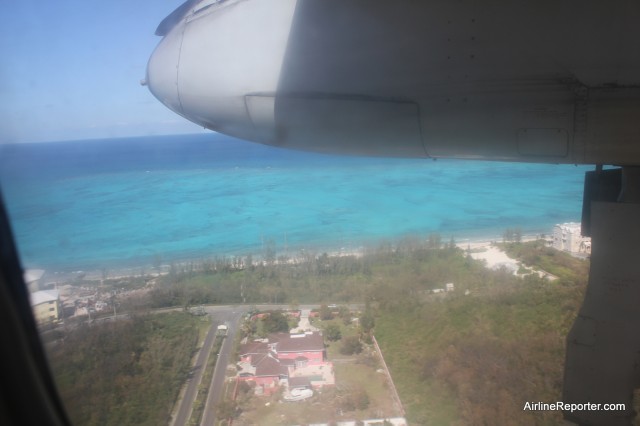
After a short 45min flight (made shorter by sleep), we were flying close over the blue waters and landing at NAS.
At about 1pm (4hrs 5min late) I boarded the second Dash 8 (which had the more colorful livery). Most people boarding with me felt like they just had one of the most horrid experiences known to man. By no means is sitting around in E-Terminal, at FLL for almost six hours, enjoyable, but this stuff happens and getting angry doesn’t make things any easier.
I had a window seat secured on the original 737 flight and got another one for the Dash 8 — seat 8A. I was hoping to get some amazing photos with the high-wing and flying low, but was disappointed to see that the windows were dirty (I assume from salt water). At 1:20pm, we (finally) took off from FLL, heading to paradise.
Previously, I have flown on Alaska Airlines and Porter Airlines Bombardier Q400s (the newest version of the Dash 8) and the difference in age and cabin interiors showed. The only carry-on that I had was my camera bag and it even had a hard time fitting in the crazy-small overhead bin (it is free to check in your first bag on Bahamasair).
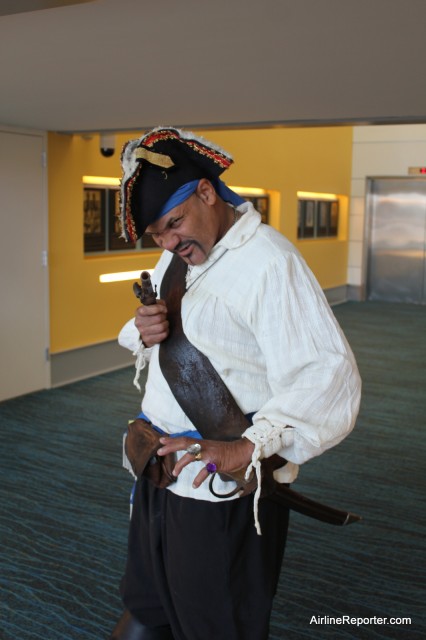
Yes. A pirate in the airport welcomed me to The Bahamas. How cool is that?
I was hoping to enjoy the blue waters during the flight, but with my lack of sleep I quickly passed out and woke up just in time to enjoy the view during landing.
I deplaned on the tarmac and was able to walk through the new international terminal at NAS. Before hitting customs, I was greeted by a pirate (yea, a frek’n pirate) who was more than happy to have his photo taken.
When dealing with a challenging travel scenario, I find it always important to find the positives. I was now in the Bahamas, I just met a pirate and my bag had made it on the first Dash 8, so it was waiting for me when I arrived at baggage claim.
My original schedule was to interview the man in charge of the airline, Van Diah, 4.5 hours earlier and I wasn’t sure if he would still was able to meet with me. I felt very privileged that he was able to work me into his packed schedule to sit down and talk about his airline. Obviously one of the big questions on my mind at the time was the airline’s reliability and on-time performance. Surprisingly, he was more than happy to discuss these and other aspects that I will share in a future story.
I have to say that just a few short minutes of getting away from the airport and seeing the beautiful blue ocean quickly made me forget the long journey it took for me to get there. I felt like the difficulties might have been worth it and I was looking forward to exploring Nassau (which will also be shared in future stories).
ADDITIONAL PHOTOS OF MY BAHAMASAIR FLIGHT
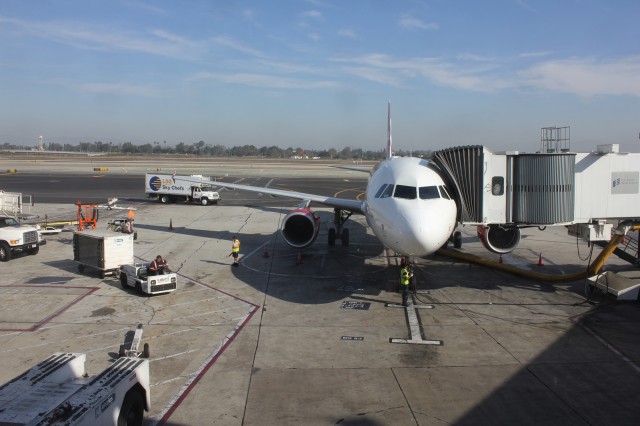
Virgin America, Breanna Jewel, sits at LAX after arriving.
VIRGIN AMERICA FIRST CLASS REVIEW BASICS:
Airline: Virgin America
Aircraft: Airbus A320 (named Breanna Jewel)
Departed: Seattle-Tacoma International Airport (SEA)
Arrived: Los Angeles International Airport (LAX)
Stops: None
Class: First Class
Seat: 1A
Length: 2.75hrs
Cheers: Best domestic first class product, hands down.
Jeers: Please wash your windows.
Bottom Line: You get what you pay for and you shouldn’t feel bad paying for this.
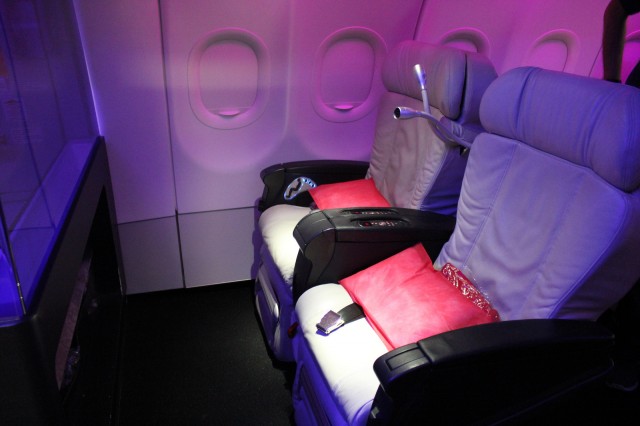
Virgin America’s first class seats are spacious and colorful.
FULL VIRGIN AMERICA FIRST CLASS REVIEW
It has been a while since I have done a review on Virgin America and when I recently flew from SEA to LAX for #Dorkfest, I decided it was time for another review. I have flown Virgin America quite a few times, but always at the back of the (air) bus. I was hoping to review their premium product; First Class and luckily I made it work out. (Note: I paid for an economy ticket and was upgraded one-way by the airline to do the review).
Having a premium ticket gave me access to use the TSA priority line at SEA. My flight was leaving at 7:10am on a Saturday, so the priority line only saved me about a minute.
After getting through security with a first class ticket, do not expect lounge access. There is no lounge for Virgin America passengers in Seattle and lounges in New York, San Fransisco and Washington DC will cost you from $35-$75 to enter, even with a full fare first class ticket.
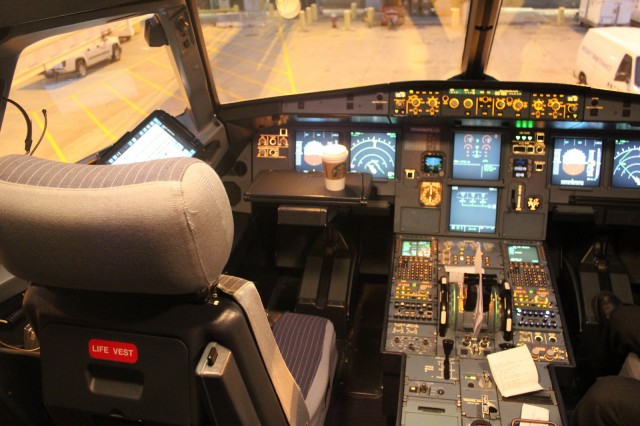
Have to love the Starbucks coffee sitting on the tray table in the Virgin America flight deck.
I was running a bit late and missed the first class priority boarding period. When doing a review, I prefer to board as soon as possible (or get pre-boarding access), but luckily the front cabin was still empty when I entered the A320.
It never gets old boarding a Virgin America flight. Where most other airlines welcome you with white lighting (snoozers), Virgin America gives you a pink and purple feast for the eyes.
Hunting down my seat, 1A, was not too difficult. After taking some photos and settling down I watched as the front flight attendant, Justin, was interacting with the kids boarding the plane. One was dressed as a superhero (seriously rad) and he was invited into the flight deck, but wasn’t having it (even super heroes have bad days I guess).
Every other child that boarded was given a similar invite, which most agreed. Well heck… I finally asked if adult-kids can go see the flight deck as well and I was more than welcome to do so. I have found that Virgin America is pretty welcoming to pre-taxi flight deck visits, which many other airlines are reluctant or just do not allow it.
After the kid in me got to check out the front of the plane, I was back to enjoying my pre-flight drink (coffee) and see what my seat has to offer.
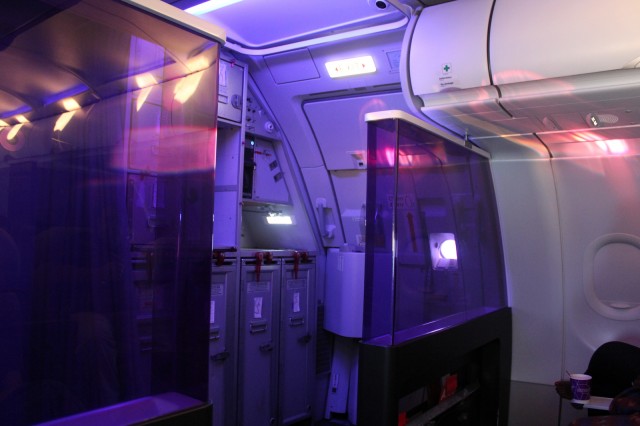
If you love purple, you will love Virgin America first class. I had to take pretty photos inside the cabin, since taking photos of the outside weren’t happening.
The safety video, which features Richard Branson’s voice, has been playing for a while now, but I haven’t quite gotten sick of it yet. However, I wasn’t able to watch it on this leg of the flight. Those in first class can hear the video, but a flight attendant shows the safety features, since the TVs remain in the armrest.
My biggest problem with the entire flight were the windows being filthy. Not a huge deal for your average traveler, but one that needs (okay, maybe wants, but it feels like a need most times) to take photos out the window. The pain became much worse when our flight flew right by Mount Rainier and out of about 30 photos taken, none of them turned out remotely decent. At least there were great things to distract me inside the aircraft.
No matter what cabin you fly in, passengers get access to free satellite TV, games, ability to order food from the screen and some of the other things that make RED awesome. The bonus of being up front is all the on-demand tv and movies are included in the price of the ticket.
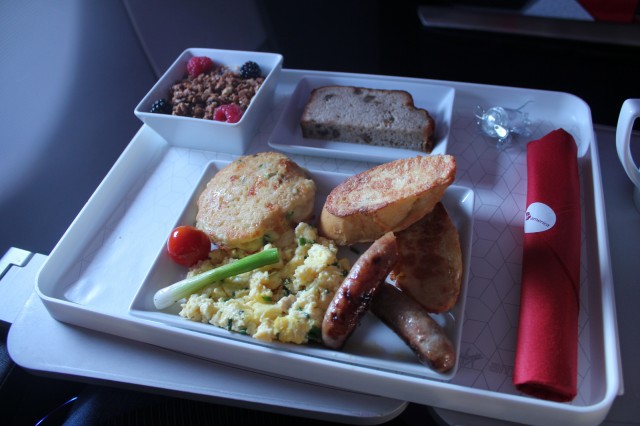
Probably the best banana bread I have had. How did they keep it so moist?
Talking about free; you also get free drinks and food. And we aren’t talking about a meal in a box food here, we are talking real food — the best I have had domestically.
For breakfast, I decided on the steel-cut oats (not sure what that means) and American breakfast: “Chilled steel-cuts oats tossed with oranges, apples, maple, walnuts, dried cranberries cherries, currants, and creamy yogurt, topped with multigrain granola, raspberries, and blackberries. Served along cage-free scrambled eggs finished with chives and cream cheese, accompanied by cheddar hash browns, apple and chicken sausage, roasted tomato, grilled green onion and mini French toast filled with vanilla and orange cream.” Dang, that is impressive — remember this is on a flight from Seattle to Los Angeles.
They even had Glenlivet 12 year old scotch, which is rare to even find on an international business class flight. Only if it was later in the day, I would have enjoyed it, but some OJ and coffee sufficed.
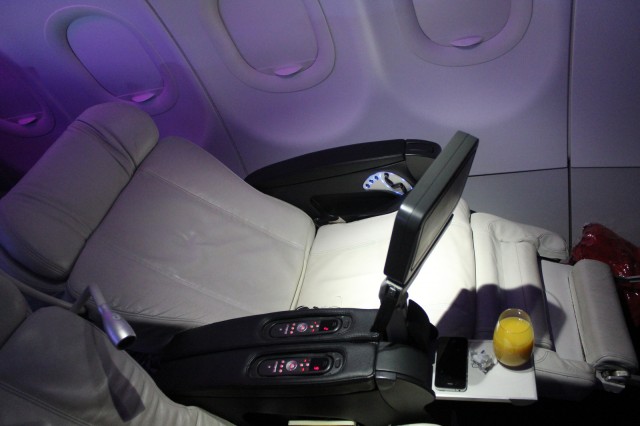
It is hard to remember this is a domestic product. Sure, the seats do not fold flat, but they get quite comfy.
If you want to guarantee a seat up in the front, make sure you purchase your first class ticket well in advance. If you are willing to take the risk, you have the ability to grab an upgrade for pretty cheap.
Elevate Gold Members are eligible to purchase First Class upgrades for themselves and a travel companion from 24 hours before departure. Elevate Silver Members are eligible to purchase First Class upgrades for themselves and a travel companion from 12 hours before departure. All other Elevate Members and other guests are able to purchase upgrades to First Class from 6 hours before departure. For a short-haul flight (like SEA-LAX) you can get a economy to first class upgrade for $79 each way. That goes up to $139 for medium haul and all the way up to $299 for long haul.
I have had no problem stating that I feel Virgin America has the best domestic economy product and I am happy to say the same about their First Class product. I am not one that has a ton of money to throw around, but I would feel okay spending the extra money for this product.
ADDITIONAL VIRGIN AMERICA FIRST CLASS PHOTOS:
[nggallery id=23]
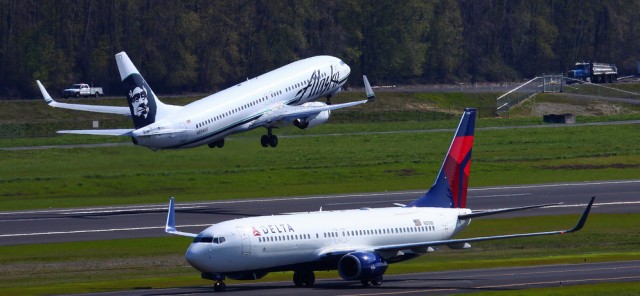
What do Alaska and Delta have up their sleeves? Photo by Paul Carter.
Today Alaska Airlines sent out a media advisory stating that their CEO, Brad Tilden, and Delta Air Lines CEO, Richard Anderson, will make a joint announcement on Monday about, “new service, product enhancements in Seattle.” What does that mean exactly? I am not sure.
The advisory continues to say that they plan, “to announce Delta and Alaska Airlines’ latest steps in Seattle, which include new service and product enhancements. Alaska operates the most flights at Seattle-Tacoma International Airport, while Delta is the market’s largest provider of Asian and trans-Atlantic service. Through their partnership, the two carriers provide air travelers with connections throughout the Northwest and elsewhere on codeshare flights, as well as reciprocal lounge and frequent flier benefits.”
Rumors about Alaska and Delta have been swarming for years. Although I doubt this is an announcement that Delta will be taking over Alaska, it has to be something pretty major for Anderson to come in from Atlanta.
What are you guesses on what the announcement might include? Leave them in the comments and let your imagination soar. We can all find out on Monday.
Thanks to Paul for letting me use his photo.
HERE IS THE ANNOUNCEMENT

















